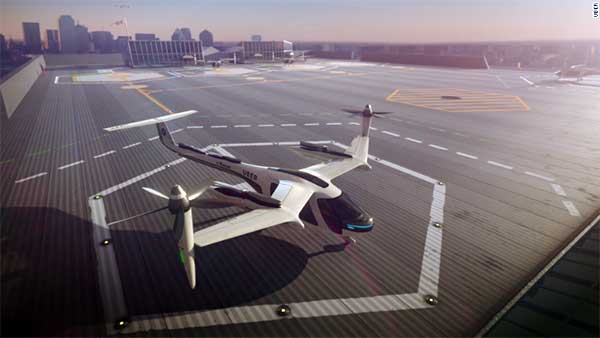UAVs provide cell service following hurricanes
2017-11-20
And other interesting drone developments.
If you blink or take your eyes off the growing unmanned aerial systems industry, you might get blind-sided — something new and significant seems to happen all the time.
We’ve heard about drones being developed to provide temporary cell-phone service before, but few have been actually used until hurricanes Irma and Maria double-devastated the Caribbean islands.
Package delivery testing in the U.S .by the big mail-order companies is showing promise, but China is already using drones to deliver fruit.
Air-transport fans of the huge Antonov AN-225 might be surprised that the Russian manufacturer has now shown up with a mid-sized UAV
Uber is working towards flying taxis
Despite all this great progress for the industry, idiots are trying to destroy all this positive work by flying drones into passenger aircraft on final approach!
Restoring Cell Coverage in Puerto Rico
We’ve all heard the mess that Puerto Rico has become following hits by, first, hurricane Harvey, and then again, by Maria a few weeks later — never mind the devastation in many of the nearby other Caribbean islands. Restoring even electrical power on Puerto Rico seems to be taking months, and many people are still subsisting on supplies flown in by the U.S. Government.
So, it’s possibly a good thing when we hear about AT&T’s flying COW (Cell On Wings) being deployed in Puerto Rico to provide temporary voice and data coverage.
This is the first time an LTE cell site on a drone has been successfully deployed to connect residents after a disaster, and is providing customers with wireless connectivity for around a 40-square-mile-area from 200 feet in the air and is currently deployed in the San Juan area.
Thanks to these and other efforts, nearly 70 percent of the population in Puerto Rico and nearly 95 percent of the population in the U.S. Virgin Islands are once again connected.
Chinese Drone Deliveries
Alibaba, the Chinese e-commerce giant, has tested unmanned aerial vehicles to deliver packages over water for the first time — from Putian in the East of mainland China to Meizhou Island. Three drones — each carrying four kilograms of passionfruit — flew into strong headwinds over the 5-km trip to cross the channel to the island in around nine minutes.
Alibaba delivery drone.
The drones were jointly developed by Alibaba’s delivery company Cainiao Network, the company’s rural shopping platform Rural Taobao, and a “domestic technology firm,” and each has capacity to carry 7 kg. Alibaba plans to use drones to deliver high value-added products such as fresh food and medical supplies over water in the future.
Another Chinese e-commerce platform, JD.com, started conducting trial deliveries using drones in 2016. Smaller drones are being used in Xi’an, Shaanxi province, and Suqian, Jiangsu province.
Big Manufacturer, Small Drone
Then we have the manufacturer of the world’s largest aircraft — the Antonov AN-225 Mriya — who has now joined the UAV club with initial test flights of the BPLA tactical UAV.
While the AN-225 is 50 percent heavier than a fully loaded USAF C-5A, the BPLA checks in with a maximum take-off weight of only 200 pounds — still a good size for a UAV.
The BPLA is similar to the Textron Shadow with a twin-boom, inverted-V tail control surface. BPLA is to be used for intelligence-gathering and artillery spotting, with Ukrainian army trials expected to take place in the spring of 2018.

Uber Partners with NASA
Uber has joined an existing industry group working under NASA’s auspices to develop an air traffic control system for drone traffic management — part of NASA’s Space Act Agreement, a consortium of industry players working to ensure “safe and efficient operations” of taxis and other small unmanned aerial systems flying at low altitudes.
With plans to introduce flying taxis as early as 2020, Uber intends to be one of the first with unmanned air vehicles carrying people around and between cities as uberAIR.
Uber previously announced city partnerships to conduct four-person ride-sharing flights in Dallas, Texas, and Dubai, with additional demos coming to Los Angeles in 2020. Uber has signed up Embraer, Mooney, Bell Helicopter and Pipistrel Aircraft to develop new vertical take-off and landing aircraft for this service — electric jet-powered vehicles that are part helicopter, part drone and part fixed-wing aircraft, with multiple rotors capable of both vertical take-off and landing and rapid horizontal flight.
The objective of the agreement with NASA is to solve issues involved in operating hundreds or thousands of driverless aircraft in, over and around cities and busy airports and potentially to enable the system to integrate them into existing air traffic control systems. Uber is building software to manage these flying taxi networks and is working with other manufacturers including Boeing’s Aurora Flight Sciences.

Bad Actor crashes Drone into Boeing 737
Despite all this positive progress for the UAS industry, some rogue operators are still making terrible decisions and risking lives by flying drones in heavily restricted airspace. The basic tenent of operating any drone in the U.S. is to be at least 5 miles away from any airport and to remain below 400 feet above ground.
Having said that, there are exceptions, but they are strictly controlled by the FAA under restricted operating procedures. What’s causing these incidents is either bad actors intending to cause potential loss of life and/or to damage passenger aircraft, or people who are negligent and don’t believe UAV operating regulations should apply to them.
A small drone flew into an Aerolineas Argentinas Boeing 737-800 in mid-October, on final approach to Buenos Aires Jorge Newbery Airport. While the aircraft landed safely, the captain of the aircraft notified the tower that a major incident was averted, after the drone struck just below the window on the commander’s side of the aircraft. Had the drone gone into the engine, it would likely have resulted in engine failure at a critical point in the aircraft’s lower energy operating regime. Loss of the aircraft could have been possible.
There were no injuries, but the aircraft did sustain minor damage and it was taken out of service for inspection and repair. Just taking a passenger aircraft out of the operational rotation for unplanned service alone can cost many thousands of dollars.
The incident is being investigated by the Brazilian National Civil Aviation Administration (ANAC) and the Civil Aviation Accident Investigation Board (JIAAC).
Wrap-up
So, good news for restoring cell coverage using drones; authorized parcel delivery by drone can’t be far away; even the big manufacturers believe in the emerging drone market; and are we closer now for flying taxis and The Jetsons’ view of tomorrow?
However, we must still do more to prevent drone incursions — intentional or otherwise — into places where they are not wanted. Lots of versions of anti-drone or area-denial systems for drones are emerging or are already on the market — let’s get some of these into place to protect commercial aircraft take-off and final approach paths as well as to protect vital and sensitive facilities.
Tony Murfin
GNSS Aerospace



